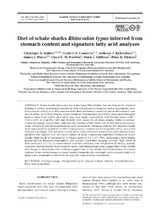| dc.description.abstract | Whale sharks Rhincodon typus are large filter-feeders that are frequently observed
feeding in surface zooplankton patches at their tropical and subtropical coastal aggregation sites.
Using signature fatty acid (FA) analyses from their subdermal connective tissue and stomach content
analysis, we tested whether whale sharks in Mozambique and South Africa predominantly
feed on these prey and/or what other prey they target. Arachidonic acid (20:4ω6; mean ± SD =
17.8 ± 2.0% of total FA), 18:0 and 18:1ω9c were major FA of whale sharks, while in contrast,
coastal epipelagic zooplankton collected near feeding whale sharks had 22:6ω3 (docosahexaenoic
acid), 16:0 and 20:5ω3 (eicosapentaenoic acid) as major FA. Stomach contents of 3 stranded sharks
were dominated by mysids (61 to 92% of prey items), another one by sergestids (56%), and a fifth
stomach was empty. The dominant mysids (82% index of relative importance) were demersal zooplankton
that migrate into the water column at night, suggesting night-time feeding by whale
sharks. High levels of bacterial FA in whale sharks (5.3 ± 1.4% TFA), indicating a detrital link,
potentially via demersal zooplankton, also support night-time foraging activity. High levels of
oleic acid (16.0 ± 2.5%) in whale sharks and their similarity with FA profiles of shrimp, mysids,
copepods and myctophid fishes from the meso- and bathypelagic zone suggest that whale sharks
also forage in deep-water. Our findings suggest that, in the patchy food environment of tropical
systems, whale sharks forage in coastal waters during the day and night, and in oceanic waters on
deep-water zooplankton and fishes during their long-distance movements. | en_US |

